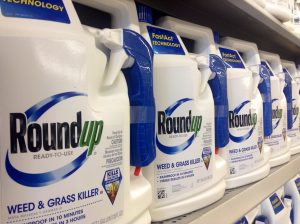11
Jan
Glyphosate Implicated in Fatty Liver Disease
(Beyond Pesticides, January 11, 2017) Ultra-low doses of glyphosate formulations fed to rats is linked to an increased likelihood of developing non-alcoholic fatty liver disease (NAFLD), according to a recently published study in the journal Nature. A lead author of the study, Michael Antoniou, PhD, stated that the findings are “very worrying as they demonstrate for the first time a causative link between an environmentally relevant level of Roundup consumption over the long-term and a serious disease.” The findings point to the growing need to eliminate the widespread use of this herbicide, as it has already been implicated in endocrine disruption, reproductive effects, and kidney and liver damage.
The researchers analyzed female rat livers obtained from a previous 2-year study on Roundup toxicity using molecular profiling techniques. These rats were administered Roundup via drinking water at a concentration of 0.1 ppb, which is an allowable level within both the U.S. and the European Union. The molecular analyses conducted by researchers on the internal organs of the rats fed Roundup included testing of liver cell disturbances. Overall, ultra-low dose glyphosate-formulation exposure led to observations of biomarkers also seen in fatty liver disease .
.
These findings have human health implications “since NAFLD is predicted to be the next major global epidemic,” according to the authors. They continue, “Approximately 20-30% of the population in the United States carry extra fat in their livers. NAFLD is associated with the recent rapid rise in the incidence of diabetes, obesity, and metabolic syndrome.” There has also been recent research linking other endocrine disrupting chemicals with the development of metabolic syndrome, although additional studies are needed to investigate the role of chronic glyphosate exposure in the development of these risk factors.
Glyphosate, produced by Monsanto, is one of the most popular weedkillers in the U.S., and the active ingredient in Roundup. Glyphosate is often promoted by industry as a “low toxicity” chemical and “safer” than other chemicals, yet has been shown to have detrimental impacts on humans and the environment. Given its widespread use on residential and agricultural sites, its toxicity is of increasing concern.
A long-awaited and contentious scientific meeting convened by the U.S. Environmental Protection Agency (EPA) on the carcinogenic properties of glyphosate wrapped up its review in mid-December 2016. The 15-member scientific advisory panel was split on their positions, with some considering a “suggestive evidence” classification. The panel’s charge was to evaluate EPA’s recent proposal that the widely used herbicide should be considered “not likely to be carcinogenic to humans,” despite a 2015 determination from the International Agency for Research on Cancer than glyphosate is “probably carcinogenic” with “sufficient evidence of carcinogenicity” based on laboratory studies. The panel now has roughly three months to provide a final recommendation to the agency, which is likely to influence EPA’s final classification of the herbicide.
Debate has also been raging in Europe about the continued use of glyphosate in light of the 2015 classification by the World Health Organization’s (WHO) International Agency for Research on Cancer (IARC) of glyphosate as a “probable human carcinogen.” However, confusion peaked when a few short months later the European Food Safety Authority (EFSA) published its report, finding that glyphosate is “unlikely to pose a carcinogenic hazard to humans.” However, EFSA’s report is limited in that it reviewed glyphosate alone, unlike IARC, which reviewed glyphosate and its formulated products (Roundup) which are more relevant for evaluating risks to human health. The European Commission has since issued a limited license extension for glyphosate, after member states were unable to come to a formal decision.
In addition to IARC’s findings, previous studies have linked the toxicant to non-Hodgkin’s lymphoma and multiple myeloma. In September 2015, a study published in Environmental Health News found that chronic, low-dose exposure to glyphosate led to adverse effects on liver and kidney health. Roundup formulations can also induce a dose-dependent formation of DNA adducts (altered forms of DNA linked to chemical exposure, playing a key role in chemical carcinogenesis) in the kidneys and liver of mice. Human cell endocrine disruption on the androgen receptor, inhibition of transcriptional activities on estrogen receptors on HepG2, DNA damage and cytotoxic effects occurring at concentrations well below “acceptable” residues have all been observed. Similarly, a study released this year finds that glyphosate can cause changes to DNA function resulting in the onset of chronic disease, including diabetes, obesity, and Alzheimer’s disease.
Given the mounting evidence of glyphosate’s hazards environmental groups, like Beyond Pesticides, are urging localities to restrict or eliminate the use of the widely-used weedkiller, like Tracy Madlener, a mother of two, successfully did last year. Beyond Pesticides promotes these actions and many more through our Tools for Change page. Consumers and advocates can work to eliminate widespread glyphosate use by buying organic, as this will support an agricultural system that is not reliant on, and in fact never permits the use of glyphosate or any other toxic synthetic pesticides. You can also urge your local grocery store and garden center to stop selling glyphosate, or any product that has ever been sprayed with the chemical. Possibly the most effective move you can make is to get active in your local community. Beyond Pesticides has resources, including a newly released Map of U.S. Pesticide Reform, to help folks concerned about glyphosate take action to reduce and eliminate its use.
Sources: Nature, The Ecologist
All unattributed positions and opinions in this piece are those of Beyond Pesticides.











I appreciate this work amazing post for us I like it.
September 11th, 2018 at 7:06 am